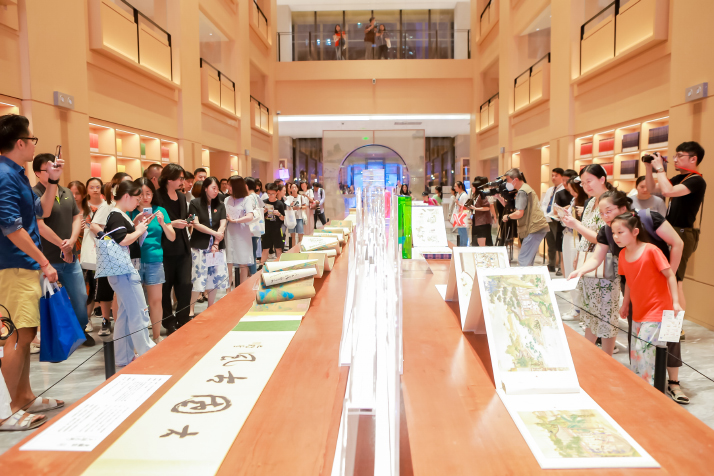| Lifestyle |
| Chinese artist resurrects long lost bookbinding techniques | |
|
|
 Visitors admire the dragon-scale bookbinding works of Zhang Xiaodong at an exhibition in Shanghai in August 2023 (COURTESY PHOTO)
At his studio in Beijing E-town on the southeastern outskirts of China's capital city, Zhang Xiaodong often immerses himself in the world of paper. As he unfolds the chapters of a book in dragon-scale bookbinding format, hundreds of sheets of thin paper flow like ripples in the wind, and illustrations composed of patterned stripes on the pages gradually come to life, creating an almost three-dimensional reading experience. Zhang is the only inheritor of this intangible cultural heritage that stretches back to the Tang Dynasty (618-907). Also known as fish-scale binding, the technique was popular among imperial houses and literate upper-class families in ancient China because it shortened the length of scrolls, improved search efficiency, and provided a pleasing reading experience. The finished works, often several meters long, were thought to resemble Chinese dragons, with each page appearing like a scale of the creature. Today, the only ancient book made with the technique is preserved in Beijing's Palace Museum, also known as the Forbidden City. The technique faded into oblivion during the transition from scrolls to books bound in covers in the Song Dynasty (960-1279). With only a few of the scrolls surviving to the present day, the technique of dragon-scale bookbinding was in danger of being lost. But then, along came Zhang. The lost art Born in 1981 in Zhangjiakou, north China's Hebei Province, Zhang graduated with a degree in industrial design from Shenyang Aerospace University and in 2006 arrived in Beijing for work. He first learned about dragon-scale bookbinding in 2008, when reading an old Chinese book describing the technique, and was fascinated by its description of "pages dancing in the breeze." Around that same time, China's digital technology was making strides, with e-readers becoming a new trend. However, Zhang believed that the printed book still had a lot of room to grow. "While e-books started to prevail, I figured some people would still prefer print books given the physical experience they offer and how they can be artworks worth collecting. With this in mind, I embarked on my career in the realm of handmade books," Zhang told Beijing Review. With the Palace Museum's one existing dragon-scale scroll as a reference, Zhang decided to revive this lost art. He delved into the technique's historical records and consulted with, and studied under, famous scholars in the field, including book designer Lu Jingren, Xiao Dongfa, a late expert on book editing, and Wang Huaizhu, a renowned bookbinding expert. He then gathered a handful of like-minded print book aficionados and together, the team set up a studio dedicated to the art of dragon-scale binding. In the past decade, Zhang has managed to complete eight dragon-scale bookbinding works and acquire 20 book design patents. In the early days, Zhang worked several part-time jobs to cover his daily expenses because he could not live off his bookbinding alone. "My mentor, Mr. Lu, was very concerned about me and would often ask if I was able to survive on these handmade books," he recalled. With some members leaving the team for financial reasons, Zhang and two other partners continued to put their heart and soul into the time-consuming work at their studio. It took almost two and a half years for Zhang to complete his first dragon-scale bookbinding work, the Diamond Sutra in 32 Seal Scripts, in 2010. The work is a 73-meter-long scroll with 217 "scales." It was believed to be the first such book to be produced in a millennium. The work is a copy of the earliest printed book in the form that we know now, with pages bound together: the Diamond Sutra, a Buddhist text estimated to have been printed during the Tang Dynasty, using woodblock printing. When unfolded, illustrations of Buddhist figures on the sides of the pages catch the reader's eye. It had been a process of trial and error for Zhang, given the completion of one work requires some 50 steps, including measuring, cutting and pasting pages. The most crucial and difficult part of the dragon-scale binding art is the precise placement of each page to perfectly create the pictures flashing before the eyes. "Even if you're off by a millimeter, when you're assembling hundreds of pages, that can make a big difference. In the beginning, I had to go back to square one, time and time again, because I did not fully understand the steps," said Zhang, adding the waste paper from those days would fill a room. During the bookbinding, he chose handmade Xuan paper produced in Anhui Province, which is famous for its supreme quality since ancient times. The making of this paper is an extremely demanding traditional craft. Sandalwood bark, a plant native to south China, along with rice straw, undergoes 108 procedures over three years before it is transformed into a batch of fine Xuan paper. "Ink will drench into the paper as time goes on and the paper is highly resistant to deterioration over time. Both factors are favorable for preserving the books," Zhang introduced. After mastering the technique at long last, Zhang made another innovation by integrating it with the accordion binding technique, another ancient method of bookbinding that uses a series of alternating folds to create books. Zhang gave full play to his innovative approach for the dragon-scale bookbinding version of the classic Chinese novel A Dream of Red Mansions. Sun Wen, an artist of the Qing Dynasty (1644-1911), created 230 images for the 120-chapter novel. After printing Sun's paintings and the novel's text onto paper at a factory, Zhang spent around four and a half years refining the work before completing it in 2015. The scroll, incorporating eight works, measures around 100 meters in length and weighs in at nearly 200 kg. Unfolding all eight segments requires a field of 3,000 square meters. Readers can easily lose themselves in amazement when appreciating the grand undertaking—it almost feels like you're watching a film.  Zhang Xiaodong poses in front of his qianye works at his studio in Beijing on January 29 (LI XIAOYANG)
More to explore Zhang's exploration has sent him down the road of paper-based art. In 2014, he took the Thangka series he'd created to be exhibited at the Potala Palace in Lhasa, southwest China's Xizang Autonomous Region. A Thangka is a traditional Tibetan painting on cotton or silk. The art dates back at least 1,500 years. However, due to the region's dry and cold climate, the sides of the paper of his works tended to curl up and the images were only partly visible. But the problems inspired Zhang to create a new technique: qianye, which literally means "1,000 pages" in Chinese. Slicing the curled sides off his works, he realized these "leftovers" were paper sculptures in their own right with distinctive visual effects. In 2019, Zhang was invited to participate in the Venice Biennale, an international art exhibition held in Venice, Italy, every two years, where he presented his qianye work Wave. "At the exhibition, some international visitors came up to me and said that they thought my works were among the most impressive exhibits," Zhang said. Earlier this year, Zhang developed a qianye work for La Mer, a high-end U.S. skincare brand, by referring to an ancient Chinese painting centered on dragons. The design merging modern expressions in turn drew growing attention to his quiet dedication to the lost art of dragon-scale bookbinding. As Zhang believes print books provide a channel for cultural inheritance, he is trying to further develop their functions. "The ancient bookbinding techniques are not outdated but, instead, provide new possibilities for the future of print publishing," Zhang said. (Print Edition Title: Bound by Devotion) Copyedited by Elsbeth van Paridon Comments to lixiaoyang@cicgamericas.com |
|
||||||||||||||||||||||||||||||
|
